Albanian identity card
The Albanian identity card (Letërnjoftim) is a national identity card issued by Albanian authorities to Albanian citizens. It is proof of identity, citizenship and residence. The current version is in ID1 format and biometric. The ID card is compulsory for citizens over 16 years of age, costs 1,500 lekë (about €10) and is valid for 10 years.[1]
| Letërnjoftim | |
|---|---|
 View of the front | |
 View of the back | |
| Type | National ID Card |
| Issued by | Albania |
| First issued | 12 January 2009 |
| Purpose | Identification |
| Expiration | 10 years |
| Cost | 1,500 leke |
History
Albania issued identity cards to citizens until 1991, the year the political system changed. For 18 years, in the absence of such a document, people were obliged to provide birth certificates with photos, which was considered inconvenient.
In 2007, with assistance from the Organization for Security and Co-operation in Europe, a central population database was created. After that, Albanian authorities called an international tender for the production of identity cards. The tender was won by the French company Sagem Sécurité (Morpho, Safran Group).[2] Albania commenced issuing identity cards on 12 January 2009.
Appearance
The Albanian ID card is a plastic credit card size card. The front contains the bearer's photo and the following fields, written in Albanian and English:
- Nationality: Shqiptare/Albanian
- Document number
- Full name, including surname and all given names
- Photograph (both printed and processed to watermark)
- Date of birth
- Place of birth
- Sex
- Personal number
- Authority
- Date of issue
- Date of expiry (normally 10 years after the date of issue)
- Signature
On the photo a micro-holographic reflecting stamp is placed. The back contains the machine readable zone.
The microchip, ![]()
Issuing procedure
An Albanian identity cards is requested at the local municipality (after paying the required fee; presently 1,500 lek or about €10) at the post office) where a digital picture of the bearer's face and fingerprints are taken. The card can be picked up in person after about 15 days, when the bearer identifies himself with his fingerprints.
Countries
An Albanian ID Card is accepted as a travel document by the following countries:
Electronic Services
Safran Aleat under the concessionary contract offers eALEAT Services, which are the new Identity Services,[8] on behalf of the Ministry of Internal Affairs (MIA),[9] through a secure platform that provides identity trust to any electronic transaction, for which Aleat is certified by NAEC.[10][11] eALEAT Services through the National ID Card offers to all Albanian Citizens the following three Services: Authentication, Authentication and DATA, and Electronic Signing.[12]
External links
References
- Government act for identity cards (alb)
- "Albania selects Sagem Sécurité (Safran Group) for secure ID documents". Archived from the original on 2012-05-26. Retrieved 2011-12-17.
- "Decision on Visas-Amendments". Article 5, Decision of 5 September 2017 (PDF).
- http://www.mvp.gov.ba/konzularne_informacije/sta_konzul_moze_uciniti_za_vas/DECISION%20ON%20VISAS%20%20-%2018.12.2014.pdf
- Agreement ALB / MNE / MKD for citizen border crossing with ID Card only
- "Archived copy". Archived from the original on 2016-08-13. Retrieved 2016-06-27.CS1 maint: archived copy as title (link)
- "Archived copy". Archived from the original on 2016-08-22. Retrieved 2016-06-27.CS1 maint: archived copy as title (link)